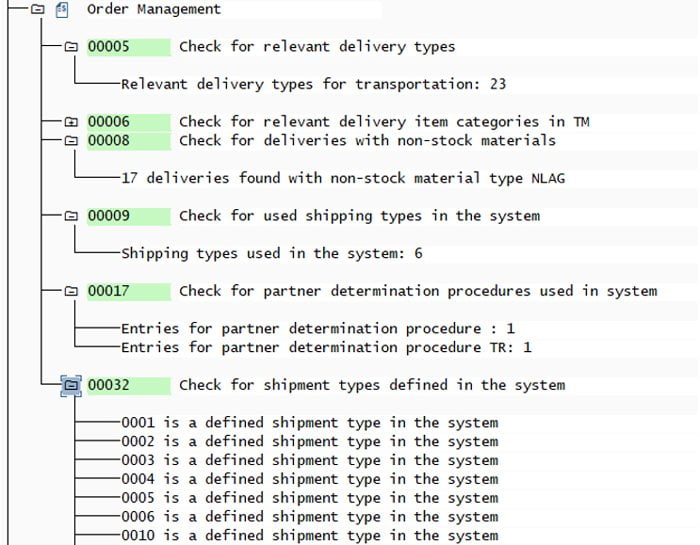Is your company thinking about introducing SAP S/4HANA? Then you are probably wondering what will happen to the LE-TRA shipment functionality that you are currently using. What we already pointed out three years ago in our blog is still true today: There is no migration path from LE-TRA to S/4HANA TM. SAP note 3097186 clearly states: “It is not possible to upgrade or migrate SAP LE-TRA to SAP S/4HANA Transportation Management.”
However, SAP has also understood the need of customers and consultants to know in detail how existing LE-TRA functionality is used. This can be one cornerstone for the setup of Transportation Management on SAP S/4HANA. A few months ago, by Note 3097186, SAP delivered a report (TM_LETRA_TO_TM_AUDIT, “LE-TRA Usage Analysis for Transportation Management”) which does a usage analysis of LE-TRA related functionality.
At present, the results of the analysis report are displayed in an ABAP tree format or alternatively as a flat ABAP list, but SAP plans to provide the information in a more printing-friendly format – as an MS Word or a PDF document e.g. – in the future. All in all, the report TM_LETRA_TO_TM_AUDIT uses over 70 classes which are doing the actual checks. Their names all start with CL_LETRA2TM_CHECK, and their numbering reflects in the result list of the report program.
A practical analysis tool for the use of SAP LE-TRA?
The results list starts with a general check of whether LE-TRA is in use at all, or not. This is done by checking the number of entries in table VTTK. After that, the results are structured into the following sections:
- Usage of Organizational Units
- Order Management
- Transactional Data
- Master Data
- Planning
- Others
- Shipment Execution
- Charge Management
- Interface
- Custom Code
For someone familiar with SAP TM, a section title like “Planning” is well-known as being a vital part of SAP TM. Other section titles like “Transactional data”, “Others” or “Order Management” are less clear and could mean anything – and in fact: not every check that is executed is actually listed in the section you might think it should be listed in.
Let’s take for example the section “Order Management”: especially for someone who is not familiar with SAP TM, it might be surprising to discover that it includes checks e.g. on delivery types where the indicator “Transportation relevant” has been set – something that in SAP TM terms is rather covered by the subcomponent Logistics Integration. It also includes checks on shipment types defined in the system – a topic that in SAP TM is covered by Freight Order Management. Another example is “Charge Management”, which in SAP TM is in fact reflected by Agreement Management, Charge Calculation and Freight Settlement.
The interpretation of the SAP analysis program requires comprehensive knowledge of LE-TRA and TM
One aspect that is actually quite annoying is the following: The checks currently don’t display any descriptions. For example, the shipment types defined in the system are listed – but without indicating the description of the shipment type. In many cases, the description can really help to identify what the shipment type is actually used for.
Or even worse: In some cases like when it comes to the relevant delivery types, only their total number is indicated, without any further details:

Another useful thing would be if the checks would not just analyze the SAP customizing tables, but also the actual usage. Example: Simply checking the shipment types that have been defined in the system is not enough – the really interesting part is if these shipment types are actually in use. Only being told that shipment type 0001 (which is delivered by SAP standard customizing) exists in the system does just not have a very high informational value.
For the section “Custom Code”, the report checks tables MODACT and MODATTR for specific transportation-related SAP enhancements that might be in use. What is missing here is a check for any BAdI implementations in Transportation (e.g. for BADI_LE_SHIPMENT or BADI_SCD_ACCTG).In addition, a check if there is any customer-specific coding that uses parts of SAP LE-TRA standard coding would be extremely helpful.
As to the Usage of Organizational Units, checking for the total number of transportation planning points that have been set up in the system is one thing. What would be more valuable for deciding on the complexity of a shift to SAP S/4HANA TM would be to know which company codes these transportation planning points belong to, if they are currently in use, and especially, if they are in use for freight costing.
To sum up, the analysis report for LE-TRA usage is not self-explanatory at all at the moment. It may barely be a starting point. Deep knowledge of both SAP ERP LE-TRA and TM is needed in order to interpret the results and ask the right questions. According to the SAP Note 3097186 that we have already mentioned, “it is planned to extend the program with recommendations how LE-TRA features and functions can be operated with SAP S/4HANA TM” for the future.
But what if you see the need to switch from LE-TRA to TM now?
We at leogistics would like to accompany you on this journey. Let us be your travel companion and prepare your individual route to SAP S/4HANA Transportation Management. Together we will examine your business needs and create a roadmap.
Christine Kettner
Senior Consultant SAP Logistics
We are here for You!
Were we able to arouse your interest?
If you have any questions about this or other topics in this blog, please contact blog@leogistics.com
TM in SAP S/4HANA Public Cloud
Are you considering a migration from LE-TRA to S/4HANA TM?
Avoidable pitfalls in production integration in SAP EWM
With The Introduction of S/4HANA, Does SAP WM Soon Belong In The “retirement home”?
4 variants of production integration with SAP S/4HANA EWM – which one is right for you?
SAP S/4HANA: The Benefits of Embedded Scheduling (Part 2/2)
SAP S/4HANA: The Benefits of Embedded Scheduling (Part 1/2)
Solving Complex Planning Problems With The Help Of Machine Learning – A Practical Example
How to successfully migrate from SAP TM 9.5 to S/4HANA TM
BLOG &
NEWS
Latest news and blog posts from the world of intelligent supply chain management.












